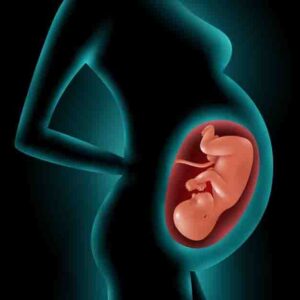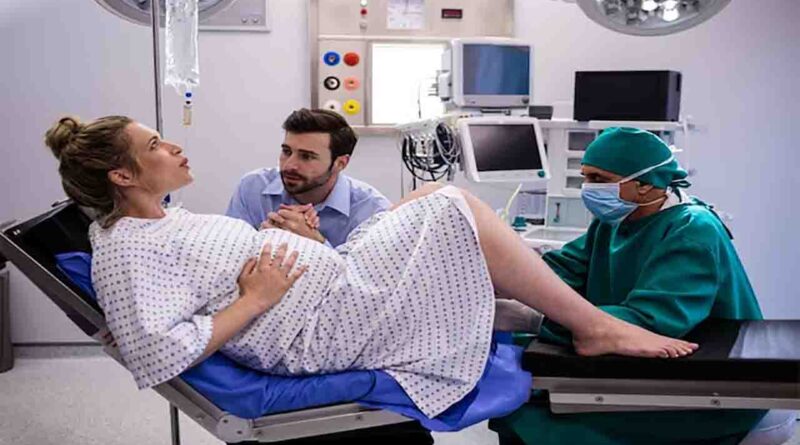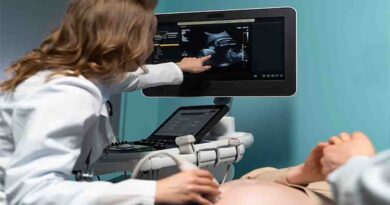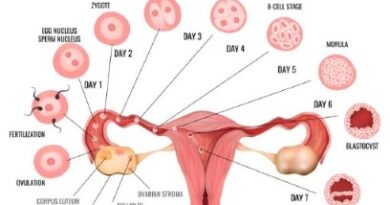Cesarean Delivery | C-Section : Purpose, Procedure & Risks
Cesarean delivery, commonly known as a C-section, is a surgical procedure that involves delivering a baby through an incision made in the mother’s abdomen and uterus. While vaginal childbirth is the natural way for a baby to be born, C-sections are performed when certain medical conditions or complications make it a safer option for both the mother and the baby. In this comprehensive guide, we will explore the purpose, procedure, and potential risks associated with cesarean deliveries.
The Purpose of Cesarean Delivery

-
Maternal Health Concerns
- Placenta Previa: When the placenta covers the cervix, blocking the baby’s exit.
- Placental Abruption: Premature separation of the placenta from the uterus.
- Preeclampsia: A pregnancy complication characterized by high blood pressure and organ damage.
- Multiple Pregnancies: Often, twins or triplets require a C-section.
- Maternal Infections: In cases where the mother has an active infection like HIV or herpes.
- Previous C-section: A previous cesarean delivery may necessitate another C-section due to the risk of uterine rupture during labor.
-
Fetal Health Concerns
- Fetal Distress: Monitoring shows the baby is in distress and needs immediate delivery.
- Breech Position: When the baby is positioned feet or buttocks first.
- Large Baby: When the baby is too large for a safe vaginal delivery.
- Fetal Abnormalities: Certain birth defects or conditions may require surgical delivery.
- Umbilical Cord Problems: If the umbilical cord is prolapsed or compressed.
-
Elective C-section
- Some mothers may opt for a planned C-section for personal or medical reasons, such as avoiding potential complications associated with vaginal birth or scheduling delivery for convenience.
The Cesarean Delivery Procedure
-
Preparation
- The mother is prepared by having her sign a consent form and receive anesthesia (usually regional anesthesia or a spinal block) to ensure she is pain-free during the surgery.
- An IV line is started to administer fluids and medications.
-
Incision
- An incision is made horizontally just above the pubic hairline or vertically from just below the navel to the pubic bone, depending on the situation.
- The abdominal muscles are separated to access the uterus.
-
Delivery of the Baby
- The baby is carefully lifted out of the uterus.
- The amniotic fluid is suctioned from the baby’s mouth and nose.
-
Placenta Removal
- After the baby is delivered, the placenta is removed from the uterus.
-
Closing Incisions
- The incisions are closed with sutures or staples, and the skin is stitched up.
-
Recovery and Post-Operative Care
- The mother is monitored closely during the immediate post-operative period.
- Pain management and antibiotics may be administered.
- Recovery time varies, but most mothers can expect to stay in the hospital for a few days.
Risks and Complications Associated with C-Sections
While cesarean deliveries are generally safe, they are major surgical procedures and carry some risks, including:
- Infection: There is a risk of infection at the incision site or in the uterus.
- Blood Loss: Excessive bleeding can occur during surgery or in the days following.
- Adverse Reactions to Anesthesia: Rarely, complications related to anesthesia can arise.
- Blood Clots: Mothers are at a slightly higher risk of blood clots after a C-section.
- Injury to Nearby Organs: The bladder or intestines may be inadvertently injured during surgery.
- Delayed Recovery: Recovery from a C-section may take longer than recovery from a vaginal birth.
- Uterine Rupture in Future Pregnancies: A previous C-section can increase the risk of uterine rupture in subsequent pregnancies.
- Respiratory Issues in Babies: Babies born via C-section may be at a slightly higher risk of respiratory distress syndrome.
C-Section Delivery side effects
Cesarean section (C-section) deliveries are surgical procedures that, like any surgery, come with potential side effects and risks. While C-sections are generally considered safe and are performed when necessary for the health of the mother or baby, it’s essential to be aware of the potential side effects and complications. Here are some common side effects and complications associated with C-section deliveries:
1. Infection: Infection at the incision site or in the uterus is a possible side effect. Signs of infection may include redness, swelling, warmth, or discharge at the incision site, or fever and abdominal pain.
2. Blood Loss: During surgery, there is a risk of excessive bleeding. Mothers may require blood transfusions in severe cases.
3. Adverse Reactions to Anesthesia: Anesthesia is administered during a C-section to ensure the mother is pain-free during the procedure. Rarely, individuals may have adverse reactions to anesthesia, which can include difficulty breathing, allergic reactions, or changes in blood pressure.
4. Blood Clots: After surgery, there is a slightly higher risk of developing blood clots in the legs or lungs. This risk can be mitigated with early mobility and the use of blood-thinning medications.
5. Injury to Nearby Organs: While rare, it is possible for the surgeon to inadvertently injure nearby organs like the bladder or intestines during the procedure.
6. Delayed Recovery: Recovery from a C-section typically takes longer compared to vaginal birth. Women may experience pain and discomfort at the incision site, making it challenging to perform daily activities.
7. Uterine Rupture in Future Pregnancies: Having a C-section increases the risk of uterine rupture in subsequent pregnancies, particularly if the mother attempts a vaginal birth after cesarean (VBAC).
8. Respiratory Issues in Babies: Babies born via C-section may be at a slightly higher risk of respiratory distress syndrome (RDS) because they miss the natural squeezing of the birth canal, which helps clear lung fluid. However, this risk is generally lower than the benefits of performing a C-section when medically indicated.
9. Scar Tissue: The incision site may develop scar tissue, which can lead to discomfort or pain, especially during subsequent pregnancies or surgeries.
10. Emotional Impact: Some mothers may experience emotional distress or disappointment if a C-section was not their preferred method of delivery, especially in cases of unplanned C-sections.
It’s important to note that the majority of C-sections are performed without serious complications, and the procedure is considered safe when medically necessary. Healthcare providers carefully weigh the risks and benefits of C-sections to ensure the best outcome for both the mother and the baby. If you have concerns or questions about C-section side effects, it’s crucial to discuss them with your healthcare provider to make informed decisions about your childbirth experience.
How many layers are cut during C-section
During a cesarean section (C-section) surgery, several layers of tissue are cut through to access the baby and safely deliver it. These layers typically include:
- Skin: The initial incision is made through the skin. The type of incision can vary, but it is often a horizontal or transverse incision just above the pubic hairline.
- Subcutaneous Tissue: Beneath the skin, there is a layer of fatty tissue called subcutaneous tissue. This layer is often separated to reach the abdominal muscles.
- Abdominal Muscles: The next layer is the abdominal muscle wall. In many C-sections, the surgeon makes an incision in the fascia (a tough connective tissue) to access the abdominal cavity. The abdominal muscles are typically separated rather than cut.
- Peritoneum: After reaching the abdominal cavity, the surgeon will make an incision in the peritoneum, which is a thin, transparent membrane that lines the abdominal cavity. This incision allows access to the uterus.
- Uterus: Once the peritoneum is opened, the surgeon will make an incision in the uterus itself. The type of uterine incision can vary, but common types include a low transverse incision (horizontal) or a vertical incision on the upper part of the uterus.
- Amniotic Sac: If the amniotic sac is still intact when the surgeon reaches the uterus, they will carefully make an incision in the sac to access the baby.
After the baby is delivered, the surgeon will close these layers in reverse order. The uterine incision is usually closed first, followed by the peritoneum, abdominal muscle fascia, subcutaneous tissue, and finally, the skin.
It’s important to note that while these are the standard layers involved in a C-section, variations can occur depending on the specific circumstances of the surgery and the surgeon’s technique. The choice of incision type and layer closure may vary from one C-section to another based on the mother’s medical history and the baby’s position. Your healthcare provider will discuss the details of the procedure with you before the surgery to address any questions or concerns you may have.
Best week for Cesarean Delivery
The timing of a cesarean section (C-section) is typically determined by medical necessity rather than personal preference. C-sections are recommended when there are specific medical indications that make it safer for the mother or baby to deliver via surgery rather than through a vaginal birth. Some common medical reasons for scheduling a C-section include:
- Breech Presentation: If the baby is in a breech position (feet or buttocks first) near the end of pregnancy, a C-section may be scheduled.
- Placenta Previa: When the placenta partially or completely covers the cervix, a C-section is usually planned to prevent bleeding complications during labor.
- Previous C-section: Women who have had a previous C-section may opt for a planned C-section (also known as an elective or scheduled C-section) or may attempt a vaginal birth after cesarean (VBAC) under certain circumstances.
- Multiple Pregnancies: Twins, triplets, or higher-order multiples often require C-sections due to increased risks associated with multiple pregnancies.
- Fetal Distress: If monitoring shows signs of fetal distress during labor, a C-section may be performed to expedite delivery and ensure the baby’s safety.
- Certain Medical Conditions: Some maternal medical conditions, such as active genital herpes or certain heart conditions, may necessitate a C-section.
- Umbilical Cord Issues: In cases where the umbilical cord is prolapsed or compressed, a C-section may be the safest option.
- Maternal Health Complications: Conditions like preeclampsia, placental abruption, or severe diabetes can increase the likelihood of a C-section.
The specific week for scheduling a C-section Delivery will depend on the reason for the surgery and the healthcare provider’s recommendations. In some cases, C-sections may be scheduled before the due date (preterm) or near the due date (full-term) to address medical concerns. The timing will be carefully determined to balance the risks and benefits for both the mother and the baby.
It’s important for expectant mothers to have open and thorough discussions with their healthcare provider regarding the timing and necessity of a C-section, as well as any potential risks and benefits associated with the procedure. Ultimately, the decision should prioritize the health and safety of both the mother and the baby.
Cesarean delivery is a life-saving procedure when medically indicated, and it provides a safe alternative for mothers and babies when vaginal birth is not advisable. However, it is essential for expectant mothers and their healthcare providers to carefully consider the risks and benefits associated with C-sections and make informed decisions regarding childbirth. Ultimately, the health and well-being of both the mother and the baby are paramount, and cesarean deliveries play a vital role in ensuring safe deliveries in complex situations.




